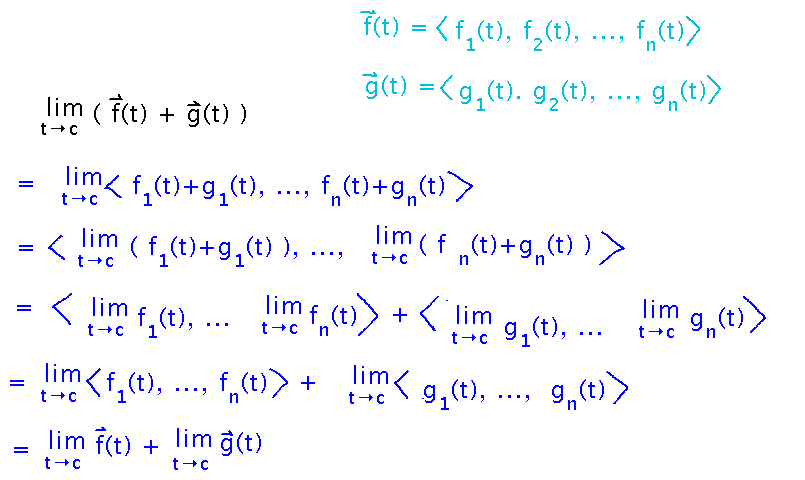Misc
Voter Registration
You’re encouraged to register (and vote); I have voter registration forms if anyone would like one.
Either return them to me or to the GOLD office.
Questions?
Limits of Vector Valued Functions
Reasoning about Limits
Prove that if f(t) and g(t) are vector valued functions of the same dimension, c is a constant, and limt→cf(t) and limt→cg(t) exist, then limt→c (f(t)+g(t)) = limt→c f(t) + limt→c g(t).
The core idea is to break the vector functions into their components, apply the limit to the components, and then reassemble vectors from the results.

Limits with Mathematica
The Limit function finds limits, and can be applied to lists (i.e., things inside { and }, i.e., vectors).
Try it on the examples from yesterday, i.e.,
- limt→-2〈 ( t2-4)/(t+2), t2-4, (2t+4)/(3t+6) 〉
- limt→0〈 1/t, 1, t 〉
See the resulting Mathematica notebook for the exact commands and their results.
Continuity
Is r(t) = 〈 t, t2, et 〉 continuous at t = 0? Yes
Formally, you need 3 things for continuity:
- r(0) is defined, in this case it equals 〈 0, 0, 1〉
- limt→0 r(t) is defined, equals 〈 0,0,1〉
- limt→0 r(t) = r(0)
How about r(t) = 〈 t, t2, et, 1/t, sin t 〉? Not continuous as t approaches 0 because the 1/t component, and its limit, are undefined when t = 0.
How about r(t) = 〈 (t2+t)/t, t2 〉? Technically also not continuous, because (t2+t)/t is undefined at t = 0. The remarkably similar function that you get by factoring, i.e., t+1, is continuous at 0, but precisely because its domain includes 0 whereas the domain of (t2+t)/t doesn’t, they are technically different functions.
Key Points
How to prove limit laws for vector valued functions.
How to find limits in Mathematica.
Continuity.
Next
Derivatives of vector valued functions.
Read the
- Derivatives of Vector Valued Functions
- Tangent Vectors and Unit Tangent Vectors
subsections of section 3.2.